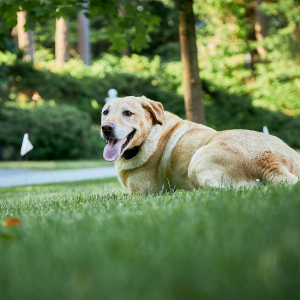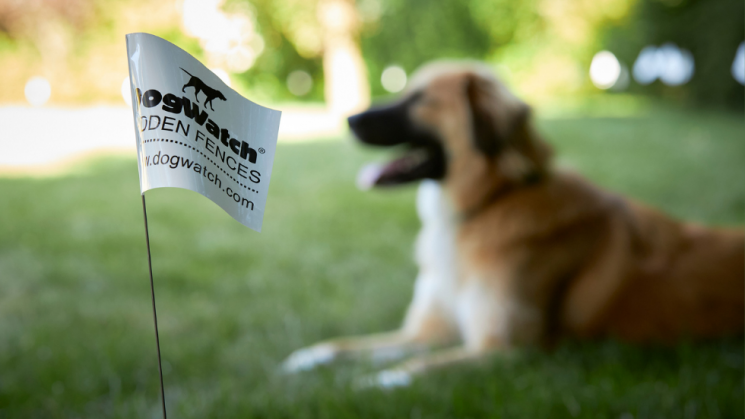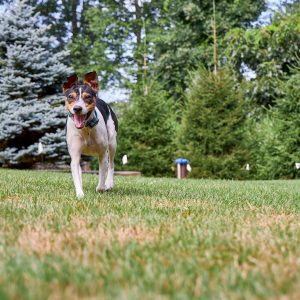Are you considering a wireless GPS electronic pet fence (frequently referred to generically as an “invisible fence”*) to keep your dog in your yard? How do wireless GPS systems compare to a traditional wired (underground) electronic dog fence? Do they provide the same level of safety for your pet?
Overview
Most electronic pet fence systems (including a DogWatch® Hidden Fence, Invisible Fence® and other brands) feature a buried wire, typically two-to-six inches underground. The wire is connected to a transmitter mounted in your house or garage that sends a harmless, coded radio signal through this wire. Your pet wears a collar programmed to detect the radio signal (called a receiver collar.)
If your pet gets too close to the underground wire, the radio signal triggers a ‘beeping’ noise from the receiver collar that alerts the dog (or cat) to retreat away from the buried wire. Through a simple training program using flags to mark the area where it is safe to play, your pet learns to recognize where it is safe and where the alert is triggered. To reinforce the training, if your pet gets too close to the buried wire, the receiver collar delivers a brief static impulse (correction). The pet quickly learns that the correction is uncomfortable and avoids the buried boundary wire. After training, most pets stay away from the buried wire and remain within the designated safe area.

Wireless GPS pet fences, by contrast, use satellites to map a specific boundary (geo-fence) for the pet instead of using a buried wire and a fixed radio signal. Mapping the fence boundary is often done by using cellular technology. The receiver collar is connected to the GPS program that sends an alert to the receiver collar if the pet approaches the boundary and corrects the pet if it does not retreat from the boundary.
While the goals of the two systems are similar, the use of GPS technology for pet containment raises several concerns.
Concern #1 – Inconsistent Boundary
- Hidden Fences with underground wires provide a consistent boundary that does not change unless the wire itself is moved.
- GPS dog fences, however, do not provide that same consistency. GPS coordinates can shift and are prone to interference and changes in signal strength.
Why is a consistent boundary so important to an electronic dog fence? In a word, training. For an electronic pet fence to work properly, the pet needs to be able to understand and recognize the containment area boundaries. A boundary that is not consistent can confuse the pet and make training and containment less effective and less secure.

Some GPS systems say they are “portable” – you can take your containment system camping, to visit friends, etc. True – you can set it up anywhere, but in addition to the inconsistency issue (and perhaps lack of power and/or satellite service), how will the dog know where the boundary is? Training (including flags, repetition and a consistent boundary) are key to successful training and a happy pet. It can be done, but it’s not as easy as advertised. And there is no way to control the inconsistent boundary.
Concern #2 – Shorter Battery Life
Battery life matters when it comes to electronic dog fences. Why? Because a dead battery means no audible alerts or corrections. As a result, the pet is much more likely to run through the boundary.
Most traditional underground electronic pet fences use a replaceable receiver battery, with a lifecycle ranging from 3 months to two years. GPS pet fences typically use a rechargeable battery to power their receiver collars. The more often you need to charge the battery, the higher the likelihood of winding up with a dead battery, which in turn increases the chance that your pet will leave the yard. Longer battery life and a battery that can be quickly changed provide more safety for your pet.
Concern #3 – Limited Uses
GPS dog fences are not recommended for smaller properties, due to the fact that the GPS boundary line can vary unpredictably (up to 10 feet). In order to keep the pet away from hazards like roads and wooded areas, the boundary line will need to be moved further away from the hazard, thus reducing the overall size of the fenced-in area.

GPS signals can also be subject to interference from a variety of sources, including nearby tall buildings. This further limits the use of these products. Thus, GPS fences are often not recommended for properties that are less than 5 acres or properties with potential obstructions.
Concern #4 – Cost
Finally, GPS pet fences are expensive. They can cost hundreds or even thousands of dollars more than a traditional underground electronic fence. Furthermore, some GPS pet fence systems require an on-going monthly fee for use of GPS and/or cellular networks.
At DogWatch, we are committed to providing the safest, most effective electronic pet fences on the market. At this time, we believe wireless GPS fences do not provide the same level of safety and reliability as traditional wired systems.
For more information about the latest in electronic pet fence technology, contact DogWatch of Litchfield County.
* Invisible Fence® and Invisible Fencing® are Brand names, products and registered trademarks of Radio Systems, Inc.








